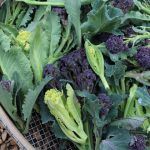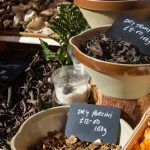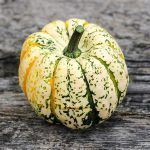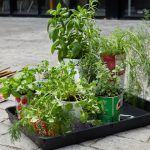I love tomatoes, perhaps more than any other garden crop, so it’s fitting that I should have spent much of Valentine’s Day sowing them. It’s now only a week later and tiny seedlings have already started to push through the seed compost. It’s the first major sowing job of my gardening year. I also sowed their relatives – aubergines, sweet peppers, chilli peppers, Cape gooseberries and tomatillos – while I was at it. They’re always a bit slower to germinate.
To return to the theme of love, it’s worth noting that an early French name for tomatoes was pommes d’amour, love apples, due to their supposed aphrodisiac quality. That’s aphrodisiac in a bad way, incidentally (think disastrous and ungodly loss of self-control). Botanists viewed tomatoes with deep suspicion simply because of their obvious kinship with poisonous nightshades. It took until the nineteenth century for them to really start catching on as anything other than an ornamental in the UK, a mere three hundred years after they first arrived from the New World.
Needless to say, it’s far too cold to sow tomatoes outside. Theoretically, the soil would be warm enough in summer but then there’d not be enough growing season left for plants to reach maturity. Tomatoes are tropical in origin. Instead, I sow into modules of seed compost in the polytunnel. Even that would be too cold if they weren’t sitting under fleece on a nice electrically heated mat to get them up to around 20°C. We have all this kit because there are a lot of plants to raise. For smaller numbers you can just use a warm windowsill, though a little heated propagator will get your seedlings off to a flying start.
All of these plants are destined to remain inside the polytunnel. I shall pot them up as they get larger and then plant them out into the indoor raised beds in April. With luck (i.e. more sunshine than last year) the first tomatoes will be ripe early in July. I have sown 71 varieties all told. They are a mixture of sizes, colours and shapes. I never tire of how good half a dozen different coloured fruits look on a plate.
About a third are small, sweet ‘cherry’ types: old favourites such as ‘Gardener’s Delight’, plus newer cultivars such as, ‘Golden Cherry’, Chocolate Cherry’, ‘Cherry Snowball’ and ‘Bonbonera’. I’m excited about ‘Emerald Green’ this year, one that’s stays green as it ripens. I wish it fell to me to name new varieties of veg. I’d show a little more imagination.
The rest are largely ‘heirloom’ varieties: old, unusual cultivars that have never entered mainstream commercial production. Thanks must go to the people – sometimes single individuals – who have determinedly kept these wonderful strains going. There are so many that I love but here are a few favourites: ‘Green Zebra’ (stripey), ‘Costoluto Genovese’ (ribbed), ‘White Beauty’, ‘Everygreen’, ‘Ananas Noir’ (positively psychedelic), ‘Russian Black’, ‘Bekaa Valley’, ‘Purple Russian’, ‘Wapsipinicon Peach’ and many, many more.
There are relatively few tomato cultivars suitable for growing outside, even in the south of England. I will sow all of these in the polytunnel at the start of April and resist the temptation to plant them outside until the start of June, by which point the last frost should have been and gone. ‘Sungold’, ‘Gardener’s Delight’ and ‘Red Alert’ will be the ones I choose for this.


















